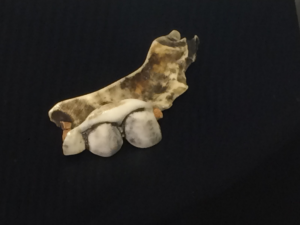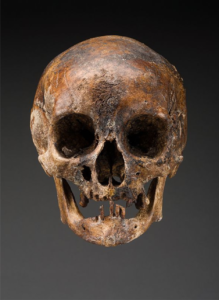Sinking Your Teeth into History: Sugar, Dentistry, and Paul Revere
By: Ruaidhri Crofton
Among the items in the Paul Revere Memorial Association’s collection is a small and somewhat morbid-looking partial denture carved from ivory. This early dental prosthetic device was not something that any Revere family member wore. Rather, the man known for his work as a silversmith also supplemented his income by practicing dentistry in the years leading up to the American Revolution, including performing teeth cleanings and replacing missing teeth with false ones.[1] What remains of this denture is attributed to Revere during his relatively short dental career in Boston and provides considerable insight into both early dental practices and the life and work of its maker. Additionally, this object also provides insight into how the rise of sugar’s popularity in colonial Boston blurred class lines and led to the need for improved and expanded dental treatment in North America. Although dental issues were nothing new to colonists, increased access to sugar in the 18th century furthered the occurrence of cavities and tooth decay, leading to a growing need for improved and more widespread dental treatment.
Although the exact origins of the denture in question are unknown, it was made at a time when North American diets had begun to shift. Today, sugar is generally cheap, commonplace, and disposable to the average consumer. However, despite how readily available it is now, widespread access to sugar has not always been the norm. In the early history of its global trade, the cost of cultivating, processing, and transporting sugar made it prohibitively expensive in the North American colonies. Only the wealthiest of families could afford to purchase and regularly consume sugar and the sweet confections made from it.[2] But with this privilege came considerable damage to the consumer’s teeth in the absence of proper dental hygiene.
For example, when Anne Wolseley Calvert, the wife of Maryland’s Colonial Governor, passed away in 1680, her coffin was made of expensive lead and her arms were tied with fine silk ribbon. Despite these markers of wealth and status, her teeth were in atrocious condition, perhaps the truest representation of her affluence.[3] According to Douglas Owsley, Head of Physical Anthropology at the Smithsonian’s National Museum of Natural History, Calvert was known to have a fondness for sweets and had “lost 20 [teeth], and several others had decayed down to the root stubs” because she had the means to regularly consume sugar.[4] In comparison, the skull of an unidentified Jamestown, Virginia man from almost a century earlier in 1607 shows a set of teeth that, while damaged, are in relatively good condition. Such a contrast can be explained by his presumed status as an indentured servant, and therefore someone who would not have been able to afford or obtain tooth-decaying sugar.
By Paul Revere’s era, the cultivation of sugar had become more widespread and efficient due in large part to slave labor on increasingly large sugar plantations in the Caribbean. Coupled with new farming technology and the expansion of Transatlantic trade routes, the “white gold” that had previously cost much more to produce, process, and transport was now more widely accessible for those with less wealth.[5] In contrast to its 17th century scarcity, by the end of the 18th century the average American was already consuming approximately six pounds of sugar annually.[6] This increased consumption had a noticeable effect on Americans who were not known to practice particularly efficient dental hygiene by modern standards. Common hygienic practices of the period included cleaning teeth “by rubbing them with a cloth dipped in a little salt and water.”[7] As a result, poor personal cleaning and hygiene fused with increased sugar consumption led to increased decay, which in turn led to increased interest in more professional cleanings and treatments such as those offered by Paul Revere.
Revere had acquired the necessary skills to perform basic dental procedures from Dr. John Baker, a surgeon-dentist from England who briefly practiced in Boston as one of the first trained dentists to arrive in America.[8] Though Revere’s work as a silversmith may not initially seem to lend itself to the dental profession, the two trades were actually relatively complimentary. For instance, ground pumice could be used to both polish silver and clean teeth. Similarly, thin gold or silver wires were needed to hold new teeth in place, which Revere’s skills allowed him to make. Advertisements posted in the Boston Gazette in 1768 and 1770 reveal that Revere fused the two occupations under one roof. The advertisements alerted interested parties that he “may be spoke with at his Shop…where the Gold and Silversmith Business is carried on.”[9] The same Boston Gazette advertisements also mention that Revere “flatters himself that from the Experience he has had these Two Years, (in which Time he has fixt [sic] some Hundreds of Teeth) that he can fix them as well as any Surgeon Dentist.”[10] Revere additionally boasted that he “fixes them in such a Manner that they are not only an Ornament but of real Use in Speaking and Eating.”[11]
Only the wealthiest people in colonial America could have afforded the work of skilled professionals (known as surgeon-dentists) in an era when trained dentists had to study in Europe and relatively few came to North America. It was unlikely that less wealthy individuals would have had the luxury of affording treatment beyond simply having a problematic tooth pulled. However, both of Revere’s claims in his advertisement suggest the beginning of a shift away from mostly wealthy individuals seeking dental treatment from a formally trained surgeon-dentist. Revere’s advertisement is a prime example of lower class residents looking to individuals like Revere who may have been less formally trained but could still provide care that would be attractive, cost-effective, and functional. Revere’s sale of toothpaste also suggests a movement toward interest in improved dental hygiene that could be performed at home.
Throughout the next two centuries, the upward trend of sugar consumption continued as trade in sugar cane expanded and cheaper sources of sugar, such as sugar beets and high fructose corn syrup, materialized.[12] Sugar in all forms gradually became a key ‘added’ ingredient in many common food items, with the average American today consuming approximately 150 pounds of sugar annually.[13] Along with this trend came a continued interest in the improvement of both dental hygiene and treatment, illustrated by the growth of American dental schools.[14] Although the history of dental medicine in North America is tied to many factors, the loss of healthy teeth from increased sugar consumption and the work of semi-professional dentists like Revere played a significant role in creating improved and expanded dental treatments. The next time you enjoy something sweet, reflect on sugar and dentistry’s long relationship and, of course, brush your teeth afterwards!
Ruaidhri is an interpreter at the Paul Revere House
[1] Object Label, Dentistry, The Paul Revere House, Boston, MA.
[2] “How Sugar Killed the Tudors”. Absolute History. April 11, 2019.
[3] Rothenberg Gritz, Jennie. “The Unsavory History of Sugar, The Insatiable American Craving”. Smithsonian Magazine. 2017.
[4] Ibid.
[5] Muhammad, Khalil Gibran. “The Barbaric History of Sugar”. The New York Times. August 14, 2019.
[6] Rothenberg Gritz, Jennie. “The Unsavory History of Sugar, The Insatiable American Craving”.
[7] Mays, Dorthy A. Women in Early America: Struggle, Survival, and Freedom in a New World. Santa Barbara, CA: ABC-CLIO, Inc., 2004: 191.
[8] Rodwin, Nina. “Dentures, Corpses, and Privies: Paul Revere’s Medical Careers”. The Revere House Gazette. No. 136 (2019).
[9] “Artificial-Teeth. Paul Revere”. The Boston Gazette. 1770.
[10] Ibid.
[11] Ibid.
[12] Cooke, D.A. and J.E. Scott. The Sugar Beet Crop. London: Chapman and Hall. 1993.
[13] “How Much Sugar Do You Eat? You May Be Surprised!”. U.S. Department of Health and Human Services. 2014.
[14] The first American dental school opened in 1840. Rodwin, “Dentures, Corpses, and Privies: Paul Revere’s Medical Careers.”


